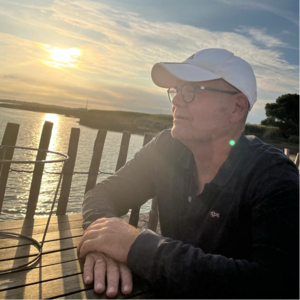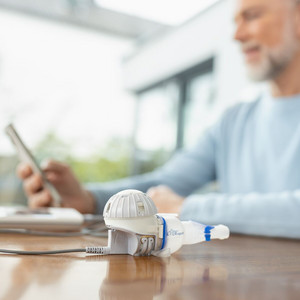
People suffering from a rare disease often have a long and difficult journey before they get the right diagnosis – and with that a suitable therapy that eases their symptoms. One of these rare diseases is relapsing polychondritis.
Translated literally, relapsing polychondritis means “recurring cartilage inflammation”. As the name suggests, with this autoimmune disease, the cartilage specifically in the ears, nose, ribs and larynx are chronically inflamed. Often the airways are affected, which can lead to coughing and shortness of breath through to respiratory failure.
Hans-Martin Schühle, who suffers from relapsing polychondritis, tells us his story.
Hans-Martin Schühle: I was diagnosed with relapsing polychondritis in spring 2002 when I was 36. For me, getting the diagnosis was a real relief because I had gone through many years of shortness of breath and the saddle nose and cauliflower ears that are typical of polychondritis. The saddle nose develops because of the constant inflammation in the cartilage, which as a result loses its firmness. Cauliflower ears is the name for the painful swelling on the ears. Before the diagnosis I had been promised a targeted therapy and, of course, a swift recovery.
My trachea only had a diameter of around 4 millimetres by that point, so I needed prompt treatment. A stent was fitted into my trachea and the left main bronchus. One of the stents broke during a coughing fit and the other one was removed in 2006. Since the diagnosis I have been taking cortisone and an immune suppressant every day. The saddle nose was corrected in 2004.
My trachea has since then been relatively stable. Over time, however, I have developed COPD as well, which is staged as GOLD 3. As I am missing a couple of the cartilage rings below the larynx, the trachea is relatively unstable at that point. A year ago it was supposed to be dilated at the stenosis but the surgery was stopped because the surgeon was worried that it would completely collapse.
Hans-Martin Schühle: The shortness of breath really restricts my day-to-day life, especially if I strain myself (physically and mentally). For example, my wife now does the gardening. When I go into a building, I always take the lift. I also find long sentences difficult – I often don’t reach the end of the sentence or have to take a shortcut and paraphrase.
I occasionally have episodes of depression and – although less frequently nowadays – panic attacks. In meeting rooms or in the cinema or theatre I basically sit at the edge of the row or near the exit. About six years ago I had a very bad phase that lasted many months, and so I changed my position at work. Keeping myself healthy is very time-consuming. That is why I will apply to go part time. I will be able to manage this quite easily because I am registered as severely disabled (70% degree of disability with disability code G: significant impairment of mobility in road traffic).

Hans-Martin Schühle: Going upstairs (I can still manage one flight of stairs) is a thing of the past. I had to rearrange my hobbies. For example, I took part in triathlons, ran marathons, went skiing and snowboarding and did all kinds of sport. In my old life I studied sport.
The disease also affects my working life. Before I have a strenuous appointment, I have to admit that I briefly increase my cortisone dose. This is because around six years ago I had to stop mid-presentation because I couldn’t catch my breath. This experience still resonates today.
Another limitation is the many appointments I have at the dermatology clinic. This is because the disease means that I suffer from multiple cutaneous precancerous lesions – pathological changes in the skin. I have already had countless basal-cell carcinomas, malignant tumours, removed. This means I have to stay in the shade and in the summer I am always out and about with a hood and long-sleeve shirts.
The diagnosis of osteoporosis is something quite new. On the same day, my cardiologist also diagnosed diastolic dysfunction, which is food for thought, but which hardly unsettles me anymore.
Hans-Martin Schühle: As well as drug therapy, regular respiratory therapy and osteopathy are part and parcel of my treatment. Respiratory therapy combines classical and reflexive respiratory therapy techniques and additional manual therapy techniques to maintain the full mobility of the structures involved in breathing – such as mobilising the ribs and vertebral joints, relaxing the auxiliary respiratory muscles and myofascial release. For me, respiratory therapy is an indispensable part of keeping me healthy.
I also do strength training two to three times a week, extensive stretch exercises and (several) daily short walkies with the dogs. For all short distances (up to ten kilometres) I use my urban e-bike wherever possible and love riding my fully-e-bike through my native black forest. Cycling is the best form of relaxation for me and also loosens the mucus. My aim is to integrate as much moderate exercise as possible into my daily routine.
I have stuck to a high fibre and vegetarian diet for many years – although I do eat fish (because of the omega-3 fatty acids). Since September 2019, I have been doing intermittent fasting (16:8).

Hans-Martin Schühle: I inhale the hypertonic saline solution MucoClear 6% in the morning and evening with the eFlow®rapid nebuliser system and in the morning I also inhale a bronchodilator. In bad phases, I do my inhalation therapy up to five times a day. Because loosening the mucus is the be-all-and-end-all for me. That is why I cannot, under any circumstances, skip it. The inhalation therapy can also bring relief. I have been feeling much better since I have been doing daily inhalation therapy.
Note: The statements made in the interview are the individual view of the persons reporting. They do not necessarily reflect the PARI view or the general state of science.
An article written by the PARI BLOG editorial team.
© 2025 PARI GmbH Spezialisten für effektive Inhalation